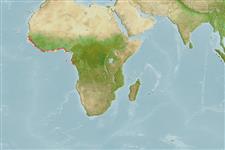Environment: milieu / climate zone / Tiefenbereich / distribution range
Ökologie
seewasser; süßwasser; brackwasser pelagisch; anadrom (Ref. 51243). Tropical; 17°N - 5°S, 18°W - 24°E (Ref. 26213)
Africa: freshwater rivers of West Africa (Ref. 188, 2244), in lagoons, lakes, lower and upper courses of rivers from Senegal to Cross River (Ref. 81269), including upper reaches of Niger and lower parts of Benue River (Ref. 188); and lagoons and lower and middle courses of coastal rivers from Cameroon to Democratic Republic of Congo (Ref. 2244, 81631). Reported from the Léfini River (Ref. 88782), but apparently not in upper parts of Congo system (Ref. 188). Also reported from Atlantic Ocean, including beaches at Hann near Dakar in Senegal and near Pointe Noire in Congo Republic (Ref. 188).
Length at first maturity / Size / Gewicht / Alter
Geschlechtsreife: Lm ?, range 3 - ? cm
Max length : 12.1 cm TL Männchen/unbestimmt; (Ref. 1989); max. veröff. Gewicht: 13.50 g (Ref. 2247)
Rückenflossenstacheln (insgesamt) : 0; Rückenflossenweichstrahlen (insgesamt) : 13 - 19; Afterflossenstacheln: 0; Afterflossenweichstrahlen: 16 - 22; Wirbelzahl: 39 - 44. Diagnosis: Body slender to moderately deep, its depth 17-30% of standard length; scutes beginning behind base of first pectoral finray, with 8-15 pre-pelvic and 6-10 post-pelvic scutes, and a total of 17-23 scutes, first pre-pelvic scute as long as following scutes lacking ascending arms; lower jaw very slightly projecting, teeth at symphysis only slightly enlarged; pre-maxillary teeth small and inward pointing, only the tips usually apparent, no strongly marked indentation at centre of jaw; lower gillrakers 20-35, equal to or longer than corresponding gill filaments; silver stripe along flank (Ref. 188, 2244, 81269, 81631). It resembles Pellonula vorax, which has larger and straighter teeth, often pointing forward, and scutes before pectoral fin bases (Ref. 188, 2244, 81269, 81631). The absence of large canine teeth in upper jaw distinguishes it from Odaxothrissa; Microthrissa species are deep-bodied and have a much more slender maxilla compared to Pellonula leonensis (Ref. 188).
Body shape (shape guide): fusiform / normal; Cross section: compressed.
Found chiefly in rivers and streams, also man-made and natural lakes (Ref. 188); also in estuaries and lagoons (Ref. 188, 2683). Apparently able to tolerate moderate or even quite high salinities (Ref. 188). It forms enormous shoals in both inshore and offshore regions of Lake Kainji (Ref. 3034). It feeds on terrestrial and aquatic insects, but also ostracods and entomostracans; stomachs containing clupeid fish scales may represent cannibalism (Ref. 188). Reproduction occurs in rivers and lakes, and may be also in estuaries and coastal lagoons (Ref. 2683). It breeds from July to September in Lake Volta (Ref. 188).
Reproduction occurs in rivers and lakes, and may be also in estuaries and coastal lagoons (Ref. 2683).
Gourène, G. and G.G. Teugels, 1991. Révision du genre Pellonula des eaux douces africaines (Pisces: Clupeidae). Ichthyol. Explor. Freshwat. 2(3):213-225. (Ref. 2244)
IUCN Rote Liste Status (Ref. 130435: Version 2025-1)
Bedrohung für Menschen
Harmless
Nutzung durch Menschen
Fischereien: weniger kommerziell; Köder: occasionally
Tools
Zusatzinformationen
Download XML
Internet Quellen
Estimates based on models
Preferred temperature (Ref.
123201): 24.4 - 27.9, mean 26.7 °C (based on 62 cells).
Phylogenetic diversity index (Ref.
82804): PD
50 = 0.7500 [Uniqueness, from 0.5 = low to 2.0 = high].
Bayesian length-weight: a=0.00851 (0.00743 - 0.00975), b=3.04 (3.00 - 3.08), in cm total length, based on LWR estimates for this species (Ref.
93245).
Trophic level (Ref.
69278): 3.3 ±0.39 se; based on food items.
Generation time: 1.1 ( na - na) years. Estimated as median ln(3)/K based on 1
growth studies.
Widerstandsfähigkeit (Ref.
120179): hoch, Verdopplung der Population dauert weniger als 15 Monate. (Preliminary K or Fecundity.).
Fishing Vulnerability (Ref.
59153): Low vulnerability (14 of 100).
🛈
Nutrients (Ref.
124155): Calcium = 347 [185, 684] mg/100g; Iron = 2.57 [1.57, 4.26] mg/100g; Protein = 18.8 [17.8, 19.9] %; Omega3 = 0.488 [0.262, 0.898] g/100g; Selenium = 43.5 [21.3, 87.1] μg/100g; VitaminA = 33 [15, 72] μg/100g; Zinc = 2.14 [1.51, 3.17] mg/100g (wet weight);
